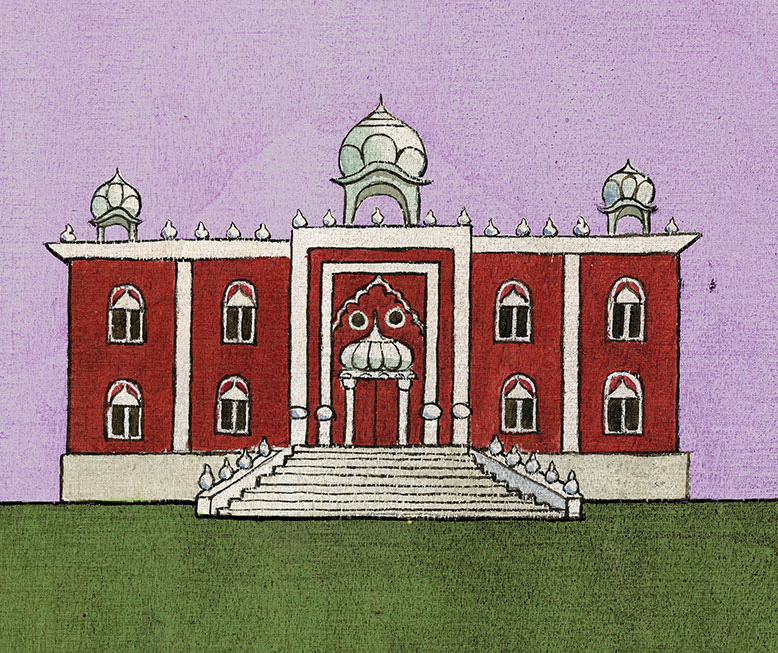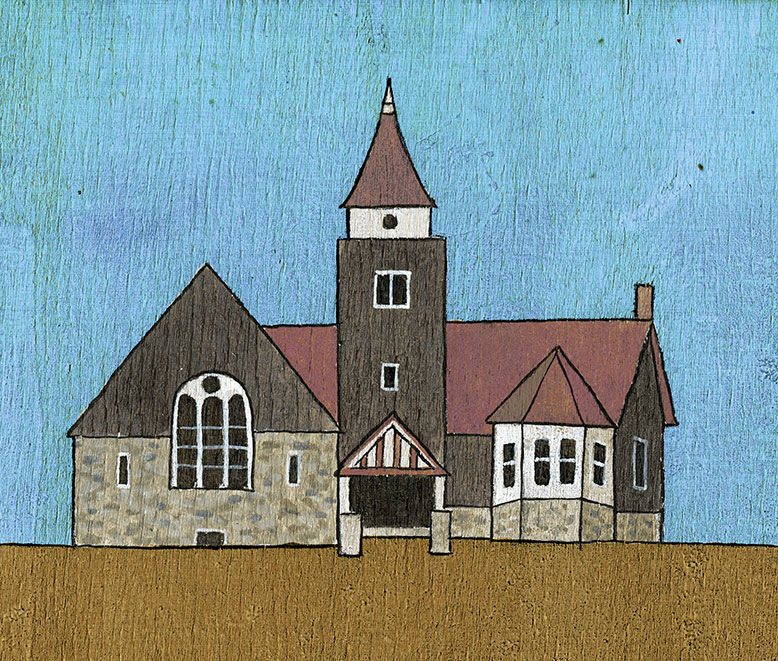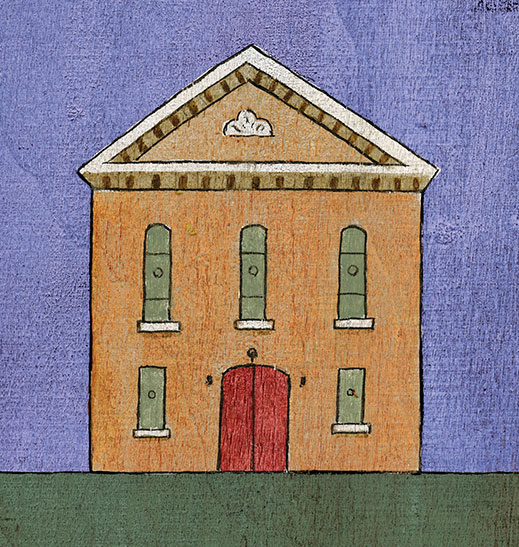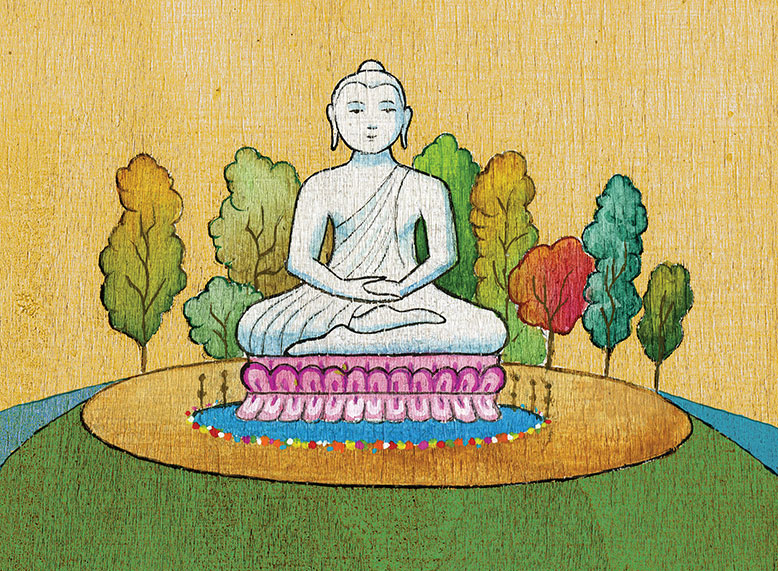Glen Rock Gurudwara
541 Prospect Street, Glen Rock; 201-251-4300
Sikh

Illustration by Stefano Vitale
Distinguished by three onion-shaped domes and a simple brick facade, the gurudwara (gateway to the guru) was built in the 1990s and serves as a house of prayer for hundreds of Sikhs in North Jersey, including Hoboken Mayor Ravi S. Bhalla.
“Sikh Americans easily blend into the fabric of American culture,” says Bhalla. “Our faith—guided by principles such as equality, justice and kindness to all—is symbiotic with the traditional American values upon which our country was founded.”
There are no idols, statues or religious pictures inside the gurudwara, which has four entrances representing the four points of the compass. To the left, immediately upon entering, you find cubbies in which to place your shoes, and a bin of colorful head scarves for women. To the right, a large hallway leads to the front of the building, where worshipers bow their heads to the floor before the Guru Granth Sahib (Holy Scripture). After leaving a monetary offering, they find a place to sit on the floor. Sikhs have no clergy or hierarchy; instead, worshippers take turns speaking of their faith.
Sikhism, the world’s fifth-largest religion, stems from the Punjab in northern India. There are about 25 million Sikhs globally, including a half million in the United States and as many as 100,000 in New Jersey. Sikhism rejects caste, which is why Sikhs often take generic last names: Singh for men, Kaur for women. Sikh males are required to wear turbans, although not all do. Women may wear a turban as well. “The turban functions as a Sikh uniform…so that anyone who needs help may be able to approach a Sikh without hesitation,” says Kavneet Singh, a New Jersey resident who is national research and advocacy officer for the American Sikh Council.
In addition to its religious functions, the gurudwara serves as a community gathering place, library and daily community kitchen.
IF YOU GO: The gurudwara is open daily from 5 am-midnight. Langar, a free vegetarian lunch, is available to all visitors. Check the website for concerts of traditional Sikh music and other events.
Leonia Presbyterian Church
181 Fort Lee Road, Leonia; 201-944-1358
Presbyterian USA

Illustration by Stefano Vitale
Other than its lush landscaping, this inviting church looks today much as it did when it opened in 1902, following the merger of a local Dutch Reformed congregation and a Presbyterian group from Jersey City. The lower part of the church is built of stone in the Tudor style; the upper portion and bell tower are faced with wood shingles. The tower, with its pointed roof, has the appearance of a lighthouse. Inside, heavy wood beams outline the arched ceilings of the sanctuary.
The church is deeply rooted in New Jersey history. In front, obscured by bushes, a marker erected on July 4, 1916, commemorates the route of General Washington’s retreat from Fort Lee to Trenton on November 20, 1776. Leonia resident Mahonri Young (1877-1957), grandson of Brigham Young, sculpted the marker.
Leonia Presbyterian prides itself on its inclusiveness and interest in other cultures. As local demographics have changed, the church has committed to serving the LBGTQ and Asian communities and all immigrant groups. That commitment includes ESL classes.
IF YOU GO: Sunday service is at 10:30 am, followed by 11:45 am ESL bible-study class; all are welcome. Call the office at 201-944-1358 to check church hours.
Mt. Pisgah A.M.E. Church
15 Yorke Street, Salem; 856-935-2374
African Methodist Episcopal

Illustration by Stefano Vitale
The roots of Mt. Pisgah reach back to colonial times. According to a document in the Library of Congress, the black congregation was founded in 1754. In its early decades, according to the document, services were held in a log church in Elsinboro, Salem County, with preaching by an unordained minister named Rueben Cuff, the son of a former slave. The log church, destroyed by fire during the Revolutionary War, was rebuilt nearby after the war.
In 1816, Cuff attended a meeting of Mid-Atlantic state black religious leaders in Philadelphia. At the gathering, members of the Free African Society expressed their displeasure at being relegated to the balcony at St. George’s Episcopal Church. “They didn’t really feel welcomed, since they couldn’t go to the altar to pray,” says Mt. Pisgah board of trustees president James Dickerson. “It’s saying you’re a member, but without full rights.”
The meeting led to the formation of the African Methodist Episcopal (A.M.E.) Church. Since Cuff was the only Jerseyan at the meeting, Mt. Pisgah became the first A.M.E. congregation in the state.
“For blacks to own property in the early 1800s was a miracle in itself,” Dickerson has written. “So, not only did a miracle occur, but by the grace of God, Mt. Pisgah has stood the test of trials, tribulations and stormy weather, as the people have toiled on. Our forefathers knew that God does not comfort us to make us comfortable, but to make us comforters.”
Mt. Pisgah built its lasting home in 1878, a two-story red brick building in what the Library of Congress calls a vernacular Classical Revival style. Its narrow stained glass windows form a symmetrical honor guard around the red doors at the center. Mt. Pisgah Church is listed on the state and national registries of Historic Places.
Dickerson, a lifelong member, says he’s proud of the church’s senior citizen and youth programs. The latter includes lessons in etiquette and encouragement of scholarship and good citizenship.
The link to the past remains unbroken in Irving Cuff, 66. A great-great grandson of Rueben Cuff, he serves as an usher at services.
IF YOU GO: Services are held Sundays at 11 am.
New Jersey Buddhist Vihara and Meditation Center
4299 Route 27, Princeton; 732-821-9364
Buddhism

Illustration by Stefano Vitale
Every Buddhist temple possesses a statue of the Buddha; at 30 feet tall, the Buddha in front of the Vihara Meditation Center is the largest in the Western Hemisphere. Erected in 2009, the seated Buddha (or Samadhi) resides on a steel and concrete base. Thanks to its size, it’s hard to miss while driving by on busy Route 27.
“Daily, we get about 100 Buddhist and non-Buddhist visitors,” says resident monk Vijitha Embilipitive. “After we established the Samadhi statue, more and more visited the temple.”
The center includes walking trails (including a meditation trail) and a gazebo. In 2016, ground was broken for an 11,000-square-foot retreat building, meditation gardens, and space for interfaith dialogue and public use.
There are roughly 488 million Buddhists in the world, with about 3 million in the United States, including about 5,000 in New Jersey, according to Embilipitive. He says most New Jersey Buddhists come from Sri Lanka, Thailand, Cambodia, Vietnam or Laos. There are various types of Buddhism, but all emphasize altruism, wisdom and relief from cyclical existence through meditation.
IF YOU GO: The center is open for meditation at the statue daily from 7 am-10 pm. Fridays from 8-9 pm, the resident monks meditate and, afterwards, are available for discussion.
—Reporting on Cathedral Basilica of the Sacred Heart by Tammy La Gorce.



